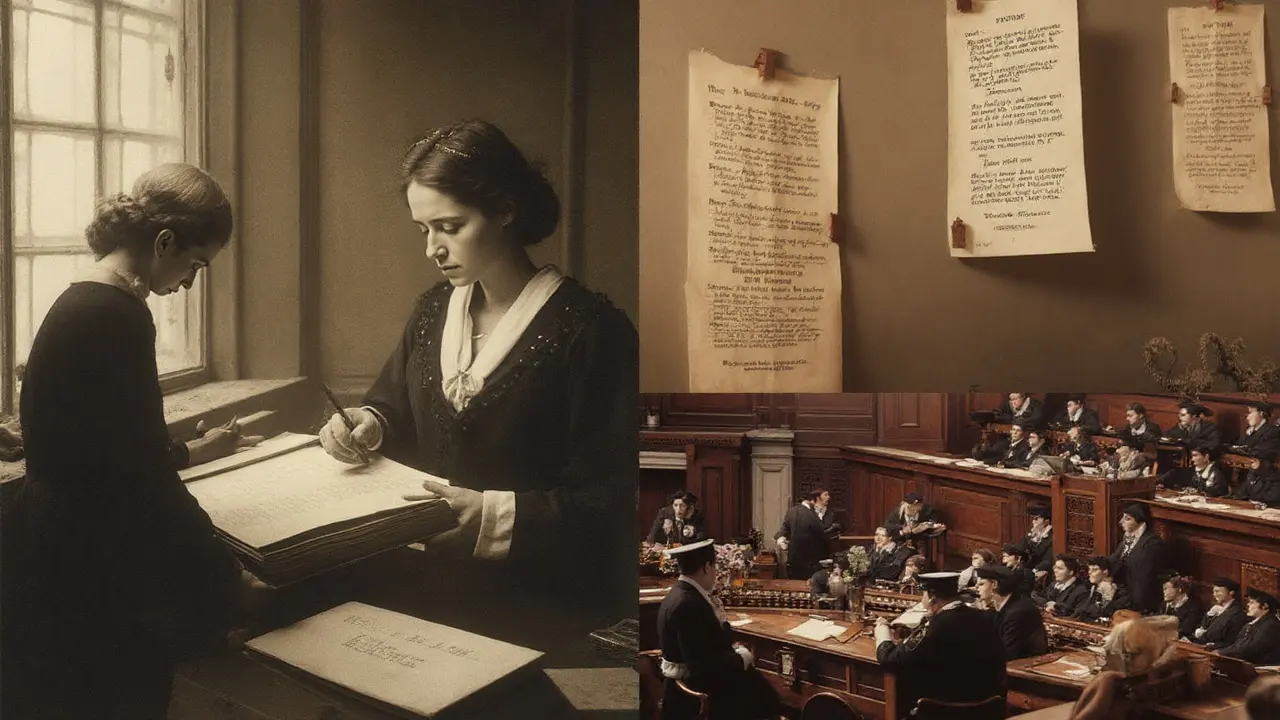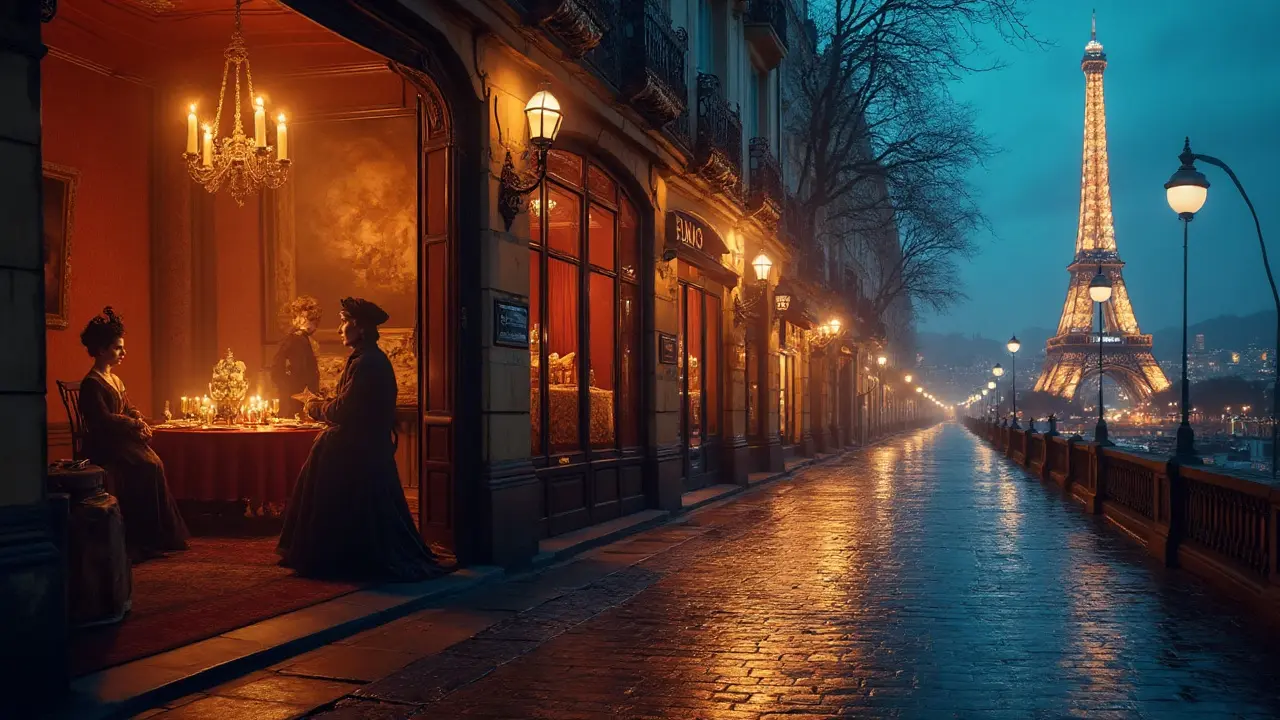Paris sells a fantasy, but the story behind it is messier, older, and more political than the postcards. This piece looks past the neon and nostalgia to trace the history of escort services in Paris-how the market evolved from salon courtesans to call girls, from brothels to browser tabs. Expect a timeline you can actually use, the laws that shaped the trade, the cultural myths that stuck, and a toolkit to keep digging without getting lost in clichés.
TL;DR - Key takeaways
- Escorting in Paris grew out of older roles-courtesans, maisons closes, and discreet “rendez-vous” flats-before shifting to phones, Minitel, and online platforms.
- Law drove the market’s shape: regulated brothels in the 19th century, closure in 1946 (Marthe Richard law), client criminalization in 2016, and ongoing platform pressure in the 2020s.
- The city’s image-Pigalle’s neon, Belle Époque glamour-often hides the split between elite companionship and precarious street economies.
- As of 2025, selling sex remains legal in France, but buying is penalized; brothels, pimping, and public solicitation are illegal.
- If you’re researching, anchor your facts in primary sources: police archives, legal texts, and reputable histories of Parisian sex work.
What “escort services” has meant in Paris-and what it hasn’t
Words change faster than laws. “Escort” is a modern umbrella term for paid companionship that may or may not include sexual services. In Paris, the label only really took off in the late 20th century, when discretion, phones, and agencies made “call girl” arrangements easier. Before that, you’d see different words for adjacent roles-“courtisane” in aristocratic and literary circles, “fille publique” in police files, or “maison de rendez-vous” in the classified ads.
Three quick distinctions help you read sources without mixing eras:
- Courtisans (17th-19th centuries): Women attached to elite patrons, moving through salons and theatre boxes, famous for wit, style, and influence as much as intimacy. Think La Païva, Cora Pearl, Liane de Pougy.
- Maisons closes (19th-mid-20th century): State-tolerated brothels registered with police (Prefecture). They had medical checks, house rules, and a price sheet-and a thick file at the vice squad.
- Escorts (late-20th century onward): Discreet, appointment-based services via phone, Minitel, and later the web. Agencies marketed “companionship” and coded language; many workers acted independently.
French law never created a neat category for “escorting.” It policed behaviors-soliciting, procuring, running a brothel-rather than job titles. So when you see “escort” in a Paris context, read it as a social and commercial practice shaped by technology and enforcement, not a fixed legal status.
Timeline: From courtesans to clicks (1600s-2025)
Use this as a step-by-step lens rather than a list of dates. The market keeps reformatting around money, fashion, and the police.
- Salons and courtesans (1600s-late 1700s): Paris elites sponsor women whose social capital is their leverage. Names circulate in diaries and plays more than in police ledgers. The city merges taste and desire; companionship is theatre, networking, and politics.
- Regulation and the birth of the vice archive (1800-1850s): After the Revolution, Napoleonic-era authorities build a system to monitor prostitution: registrations, medical exams, tolerated houses. Parent-Duchâtelet’s 1836 study, written with access to police files and hospitals, becomes the reference for 19th‑century Paris (Parent-Duchâtelet, 1836).
- Second Empire spectacle (1850s-1870s): Paris renovates itself under Haussmann. “Grandes horizontales” turn notoriety into a brand; Le Chabanais and other luxury houses curate themed rooms. Zola’s “Nana” (1880) captures the mix of money, myth, and moral panic.
- Belle Époque to interwar (1880s-1930s): The market stratifies: street trade around the grands boulevards, regulated maisons, and discreet “rendez-vous” apartments. Newspapers run coded ads; photographers and illustrators export the Paris fantasy abroad.
- Occupation and rupture (1940-1946): WWII reshuffles control-some brothels are commandeered; health checks intensify. Then the break: the Marthe Richard law (1946) orders closure of maisons closes. Legal brothels disappear; the market goes private, apartment-based, and mobile.
- Postwar gray zones (1950s-1970s): Pigalle and Rue Saint‑Denis become shorthand for the night trade. “Maisons de rendez-vous” operate off the books. Phone switchboards start to matter; agencies promise discretion to business travelers and artists.
- Minitel rewires contact (1980s): France’s proto‑internet puts ads and chats behind “3615” services. It’s fast, local, and semi‑anonymous. Escorts and clients connect without street work, a major shift in how appointments are arranged.
- From pagers to platforms (1990s-2000s): Mobile phones, SMS, and classifieds move the market online. Agencies post standard bios; independents build early websites. The language tilts to “escort,” “model,” “massage,” and “companionship” while laws stay focused on procuring and solicitation.
- New rules, new risks (2010s): The 2016 law penalizes buyers nationwide. Street contact shrinks in some areas; online screening gets tighter; workers report shifts to private apartments and outcalls. Courts uphold the law’s constitutionality in 2019, even as unions like STRASS protest its effects on safety.
- Platform pressure and hybrid work (2020-2025): Pandemic restrictions hit face‑to‑face services; some workers diversify into subscription content and camming. Platforms tighten moderation; agencies rebrand as “companionship” consultancies. Ahead of international events and media cycles, enforcement spikes in hotspots like Pigalle and the Bois de Boulogne. As of 2025, the buyer‑penalty model remains in force; debates continue in Parliament and the press.
Era-at-a-glance heuristics to keep your bearings:
- Follow the contact channel: salons (talk), brothels (doors), phones (switchboards), Minitel (codes), internet (profiles). Each channel spreads business across the city differently.
- Watch the police file: when authorities centralize records, the market concentrates; when rules hit public space or buyers, services retreat to apartments, hotels, and encrypted chats.
- Track the brand story: courtesan celebrity, Belle Époque interiors, Pigalle neon, agency gloss, platform anonymity. The brand shapes who pays and what they expect.

Law and order: the rules that drew the map
French policy doesn’t label “escorts” as a class. It regulates activities around sex work. These are the pivots that changed Paris most:
- 19th‑century regulation: Police des moeurs (morals police) licensed brothels, enforced health checks, and controlled addresses. The logic was containment: keep it visible to monitor it.
- Marthe Richard law (1946): National closure of maisons closes. The state outlaws brothels but not the sale of sex itself. Work shifts to clandestine flats, bars, and street corners. Sources: Journal Officiel (1946); contemporary debates cite public health and women’s dignity.
- UN Convention (1960s) and French reforms: France aligns with international norms against exploitation and procuring. “Proxénétisme” (pimping, living off the earnings, facilitating) becomes a central target in the Penal Code.
- Public solicitation (2003): The Internal Security Law (LSI) criminalizes “passive soliciting,” giving police discretion to act on appearance and presence. Critics say it pushes workers into less visible, riskier settings.
- Buyer penalty (2016): The law n° 2016‑444 penalizes clients with fines and “awareness courses.” It promises support services for workers and aims to reduce demand. The Constitutional Council upholds key articles in 2019.
Where things stand in 2025 (simplified, but accurate):
- Selling sex: not a crime under national law.
- Buying sex: penalized; repeat offenses can trigger higher fines and mandated classes.
- Brothels: illegal; running or profiting from one falls under procuring.
- Procuring: broadly defined and heavily punished-in practice, this can cover agency owners, drivers, web admins who knowingly facilitate, and landlords who exploit.
- Public solicitation: prohibited; enforcement varies by district and political pressures.
This legal mix explains the shape of the Paris market since the 2000s: fewer open streets, more private apartments and hotel outcalls, and a steady migration to digital channels that try to avoid obvious “facilitation.” When platforms clamp down or police set up stings, business reroutes through encrypted messaging or word-of-mouth circles.
If you’re fact-checking, prefer primary sources:
- Parent-Duchâtelet, “De la prostitution dans la ville de Paris” (1836) for the regulated era.
- Alain Corbin, “Women for Hire” (1986, French original earlier) for 19th‑century social history.
- Jill Harsin, “Policing Prostitution in Nineteenth‑Century Paris” (1985) for the vice squad and urban control.
- Text of the 1946 law and the 2016 law; Constitutional Council decision 2019 on constitutionality.
Culture, media, and money: why Paris keeps selling the same dream
Paris packages intimacy as style. That’s not new. The city fused companionship with culture well before the word “escort” existed. The spectral figure changes costumes-a duchess’s protégée, a Belle Époque celebrity, a 1960s call girl-but the pitch stays steady: discretion, taste, and a feeling that you were there with someone who belongs.
Three forces kept the story sticky:
- Literature and film: Zola’s “Nana,” Maupassant’s short stories, and later films like “Belle de Jour” (1967) built a Paris where desire is stylish and dangerous. These aren’t documentaries. They’re mood boards that outlive the facts.
- Tourism and nightlife: Pigalle’s cabarets and the sex‑shop strip turned the district into a neon logo. For escorts, that pulled both ways: visibility brings clients and police attention. The quiet money stayed uptown, in apartments and hotels, well away from the postcard.
- Tech as concierge: Switchboards, Minitel, and the web let agencies polish bios, manage bookings, and screen clients. Independents built brands. The more curated the profile, the closer the service looks to high‑end companionship, and the further it feels from the street in the public mind.
Under the gloss, the economics split. High‑spend, low‑volume work tends to cluster around business districts, luxury hotels, and private referrals. Lower‑spend, high‑volume work historically clustered around transport hubs and nightlife areas. The Bois de Boulogne picked up a share of trans and migrant workers; Rue Saint‑Denis and Pigalle saw police cycles and gentrification pressure. When buyer penalties and solicitation bans tighten, outcall and private spaces take over.
Worker voices complicate the narrative. STRASS, the sex worker union founded in 2009, documents safety concerns tied to crackdowns and calls for labor rights. NGOs focused on trafficking highlight coercion cases and argue for stronger exits and enforcement. Those positions collide in policy debates, which is why the 2016 model remains under constant review. Read across the spectrum before you draw firm conclusions.
A note on gender and migration: Paris has always had a mixed market-cis women, trans women, nonbinary workers, and men. Migration patterns shape language and routes. In the 1990s and 2000s, Eastern European and West African migration showed up in police reports and outreach programs; the 2010s added new corridors. Any single “Paris escort” image leaves out most of the city.
How to read the glamor without getting fooled:
- Match image to infrastructure: a photo in a themed Belle Époque room likely points to a pre‑1946 maison close; a pager on the nightstand screams 1990s call girl; a “discretion and travel” tagline belongs to the agency era.
- Check the contact path: if an ad lists a street corner, you’re in a pre‑2003 or early web context; if it points to encrypted chat or bespoke screening, you’re in the 2016+ era.
- Follow money density: when policing is strict, high‑spend clients concentrate in vetted circles; lower‑spend markets disperse or migrate to less patrolled edges.
Research toolkit: sources, cheat-sheets, and fast answers
You don’t need a PhD to work responsibly with this subject, but you do need a method. Use these tools to keep your notes clean and useful.
Reliable starting points
- Historical core: Parent-Duchâtelet (1836); Alain Corbin’s studies on 19th‑century sexuality and social regulation; Jill Harsin on policing; works by historians of gender and labor.
- Law texts: Penal Code on procuring; 1946 brothel closure law; 2003 Internal Security Law on solicitation; 2016 buyer-penalty law; Constitutional Council decisions.
- Archives: Archives de la Préfecture de Police; Archives nationales for ministerial debates; Bibliothèque nationale de France for press ads, photographs, and ephemera.
- Museums and media: Musée d’Orsay for Belle Époque visual culture; films like “Belle de Jour” for cultural framing; contemporary journalism from reputable outlets for 2010s-2020s policy impacts.
Cheat-sheet: quick timeline by format
- Courtesans and salons (to 1800s): patronage and social capital.
- Regulated brothels (1800s-1946): police licenses, medical controls, famous maisons.
- Discreet flats and phone work (1950s-1970s): switchboards, doormen, hotel circuits.
- Minitel (1980s): 3615 services; coded ads with fast booking.
- Web and mobiles (1990s-2000s): agencies and independents build online profiles.
- Buyer penalties and platforms (2016-2025): screening, private spaces, encrypted contact.
Glossary for reading Paris sources
- Courtisane: Elite companion with social clout; 18th-19th century icon.
- Maison close: Licensed brothel, closed in 1946.
- Maison de rendez-vous: Discreet, apartment-based operation, often illegal post‑1946.
- Racolage: Solicitation in public space; criminalized in modern law.
- Proxénétisme: Procuring; facilitating or profiting from sex work; heavily penalized.
- Minitel: France’s pre‑web online system; transformed appointments in the 1980s.
Comparisons that clear common confusion
- Courtesan vs. escort: Courtesans traded on public celebrity and patronage; escorts trade on privacy and scheduling. Both sell time and presence; the venues, contracts, and law differ completely.
- Brothel vs. agency: A brothel houses the encounter and is illegal in France since 1946. An agency markets and books meetings; depending on facts, it can be treated as procuring under French law.
- Street vs. outcall: Street work relies on public contact; outcall uses phones and platforms. Enforcement hits these models differently.
Pitfalls to avoid
- Don’t project today’s terms backward. “Escort” in an 1890 ad is an anachronism; read for “rendez‑vous,” “maison,” or coded euphemisms.
- Don’t treat glamour as typical. The market’s median experience is never the postcard.
- Don’t conflate trafficking and independent work. Both exist; they require different evidence and policy responses.
- Don’t ignore the buyer. Laws that target clients rewire contact, not just supply.
Mini‑FAQ
- Is escorting legal in Paris? Selling sex is not a crime, but buying is penalized since 2016. Brothels and procuring are illegal. Public solicitation is also prohibited. Many activities that look like “managing” or “facilitating” can fall under procuring, so arrangements often move to private and online spaces.
- When did brothels close? 1946, nationally, by the Marthe Richard law. Some clandestine venues continued, but legally sanctioned maisons closes ended then.
- What changed with Minitel and the web? They removed the need for public contact, sped up screening, and let agencies and independents market discreetly. That shift set the stage for today’s platform‑driven bookings.
- Did the 2016 law end escorting? No. It changed how contacts are made and who takes risks. Research and advocacy groups report displacement effects and safety concerns; supporters argue demand falls and exits rise. Both cite data; read critically.
- Where did the “Paris escort” image come from? It mixes courtesan myth, Belle Époque interiors, Pigalle’s nightlife, and agency branding from the 1990s onward. It’s a collage, not a single era.
Next steps
- Students and writers: Build a short annotated timeline for your project, with one primary source per era. Quote legal texts precisely to avoid drift.
- Journalists: Pair policy pieces with on‑the‑ground reporting from unions and NGOs. State what your sources can and can’t show (sample size, geography, period).
- Curious travelers: If you’re exploring the city’s cultural history, stick to museums, archives, and reputable tours about nightlife history. Avoid turning living neighborhoods into spectacle.
- Fact-checking dates: Cross‑check with Prefecture archives and the Journal Officiel for laws. If a claim hinges on a single memoir, treat it as color, not proof.
Paris didn’t invent paid companionship, but it branded it better than anyone. The legal pivots, the tech switches, the neighborhoods that glow and dim-those are the levers. Pull them, and the story stops being murky and starts making sense.

